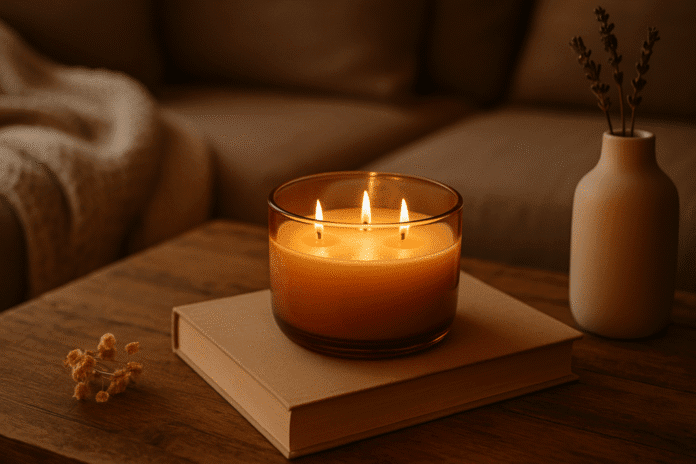Creating a welcoming and relaxing home often depends on small details that shape how a space looks, feels, and even smells. One of the most versatile tools for shaping ambiance is the use of scented candles, especially when purchased during a 3 wick candle sale, which combines affordability with quality. Beyond their fragrance, candles offer visual warmth, aesthetic appeal, and emotional comfort. Choosing the right candles, however, requires weighing several factors: burn time, fragrance type, wax material, and even price. Understanding the trade-offs involved can help homeowners and lifestyle enthusiasts make thoughtful decisions about how to create a cozy home atmosphere.
Table of Contents
Why Candles Remain a Timeless Home Essential
Candles have been part of human life for centuries, initially used for light before becoming objects of style, scent, and mood. In modern interiors, candles are not just accessories; they are multi-sensory enhancers. The soft flicker of a flame provides a natural light source that relaxes the eyes, while fragrance molecules dispersed into the air create a subtle backdrop that influences emotions and perception.
The appeal lies in their versatility. Unlike permanent fixtures such as furniture or lighting systems, candles are flexible and easily changed. A candle can move from the living room to the bathroom, adapting to different occasions. This adaptability explains why many households consider candles an affordable luxury—an item that improves quality of life without requiring extensive investment.
The Distinct Value of Three Wick Candle Designs
Among the many varieties available, the three wick candles have gained popularity for both functional and aesthetic reasons. The presence of three flames allows the wax to melt more evenly, preventing the tunneling effect often seen in single-wick jars. This translates into a cleaner burn and a longer-lasting product.
From a fragrance perspective, multiple flames release scent molecules more effectively. A triple wick candle typically disperses fragrance across larger spaces, making it particularly suitable for living rooms, open kitchens, or shared dining areas. For individuals who want their entire home to carry a consistent aroma, this design provides strong value.
The visual element should not be overlooked either. Three flickering flames create a more dramatic light effect than a single flame, adding depth and warmth to the environment. This aesthetic presence enhances special occasions such as dinners, celebrations, or even quiet nights spent reading.
How Fragrance Shapes Ambiance
While the visual glow is important, the identity of a candle lies in its fragrance. Scent has a direct influence on mood, memory, and perception of space. Choosing the right scent candles requires understanding both personal preference and room function.
- Citrus and fresh blends often suit kitchens or entryways because they evoke cleanliness and energy.
- Floral profiles bring softness and romance, suitable for bedrooms or intimate dining areas.
- Woody or musky scents establish grounding, making them ideal for studies or living rooms where relaxation and focus matter.
- Spiced or gourmand aromas mimic the coziness of baking or seasonal warmth, common in fall and winter months.
The challenge comes from balancing personal taste with household needs. What one person considers refreshing may feel overwhelming to another. Families or households with multiple occupants must often find compromise scents that appeal broadly without being too polarized.
Wax Composition and Its Trade-Offs
Candles today come in different wax compositions: paraffin, soy, beeswax, coconut, or blends. Each material has benefits and challenges.
- Paraffin wax is inexpensive and holds fragrance strongly, but it is petroleum-based and sometimes criticized for emitting more soot.
- Soy wax burns cleaner and is renewable, but it may not deliver fragrance with the same intensity as paraffin.
- Beeswax offers long burn times and a natural honey scent, but it is often more expensive and less versatile for fragrance blending.
- Coconut wax is gaining attention for its sustainability and excellent fragrance throw, but it is still niche and higher in cost.
Consumers deciding between these options face a balance between performance, environmental considerations, and affordability. For example, someone prioritizing budget may lean toward paraffin, while an eco-conscious buyer may accept a higher price for soy or beeswax.
Burn Time and Practical Considerations
One of the most significant practical factors when purchasing candles is burn time. Larger jars, particularly the triple wick candle, tend to burn through wax faster due to multiple flames, yet the fragrance pays off is stronger. A single wick may last longer in hours but provide weaker fragrance coverage.
This trade-off raises an important decision point: should the buyer prioritize longevity or intensity? For someone who burns candles only occasionally, a longer-lasting single wick may suffice. For those who use candles daily and want immediate ambiance, the stronger throw of a three-wick candle is worth the faster burn rate.
Additionally, proper wick trimming and burn practices significantly affect performance. Allowing a candle to form a full melt pool during its first use prevents tunneling, while keeping wicks trimmed reduces soot and extends the life of the jar. These maintenance habits help maximize investment regardless of wick count.
Pricing and the Role of Sales
Candles exist in a wide range of prices, from budget supermarket options to luxury designer jars. For many households, affordability remains important, which is why promotions such as a 3 wick candle sale can influence purchasing behavior. Sales allow customers to experiment with new scents, stock up for different seasons, or buy in bulk for gifting without financial strain.
However, buyers must also weigh the difference between price and value. A cheaper candle with poor burn quality or weak fragrance may end up wasted, while a moderately priced candle with strong performance delivers better value over time. Sales are most beneficial when they involve brands known for consistency and quality, rather than offloading lower-quality items.
Candles as Lifestyle Accessories
Beyond function, candles serve as lifestyle markers. A carefully chosen candle signals attention to detail in home styling. Jar designs and labels contribute to visual identity, often complementing interior themes. Minimalist glass jars may appeal to modern décor enthusiasts, while ornate containers align with traditional or rustic homes.
Candles also intersect with wellness trends. Many people view aromatic candles as tools for relaxation, meditation, or stress relief. Lavender, chamomile, and sandalwood, for example, are often linked with calming effects. This wellness association broadens the audience for candles beyond mere decoration, positioning them as part of a holistic lifestyle approach.
The Gift Appeal of Candles
Candles remain one of the most popular gift items for all age groups. Their universal appeal makes them suitable for birthdays, holidays, housewarming, and thank-you gestures. The fact that they are consumable yet long-lasting adds practicality.
From a buyer’s perspective, gifting raises considerations such as fragrance neutrality. While bold or niche scents may please personally use, gift buyers often lean toward safer choices such as vanilla, citrus, or mild florals. This creates a tension between individuality and safety: should the giver choose a unique scent to stand out, or a neutral one to avoid risk? The answer often depends on how well the giver knows the recipient’s preferences.
Seasonal Trends and Rotations
Seasonal marketing plays a strong role in candle sales. Autumn and winter are peak periods, with pumpkin spice, cinnamon, pine, and vanilla dominating shelves. Spring and summer introduce lighter options such as citrus, linen, and oceanic blends. For households, this rotation keeps ambiance fresh and aligned with seasonal moods.
The challenge comes with storage and over-buying. Candle enthusiasts often purchase more than they can burn in one season, leading to unused stock. Since fragrances can weaken over time if stored improperly, over-buying reduces overall value. A balanced approach is to purchase enough to enjoy variety but not so much that candles sit unused for years.
Health and Safety Considerations
While candles are safe when used responsibly, they do carry safety considerations. Open flames present risks in households with pets or children. Fire-safe placement, such as keeping candles away from fabrics and ensuring stable surfaces, is critical.
Some consumers also express concern about indoor air quality. Although studies show that most modern candles, when burned correctly, produce minimal pollutants, sensitive individuals may prefer natural waxes or essential oil-based fragrances. Choosing well-tested brands reduces this concern, as reputable manufacturers follow safety guidelines on wick and wax composition.
The Challenge of Over-Fragrance
Another challenge is over-fragrance. In smaller rooms, a strong scent candle can become overwhelming, leading to headaches or discomfort. Balancing candle size with room size is important. For example, a large triple wick candle suits a spacious living room but may overpower a small bedroom.
Layering multiple candles in different rooms can also create clashing scents if not coordinated. A citrus kitchen candle may conflict with a heavy musk in the living room. Successful layering involves complementary profiles—such as pairing citrus with herbal, or wood with spice.
Environmental and Ethical Concerns
Modern consumers increasingly care about sustainability. Candle production involves farming, processing, and shipping materials, all of which have environmental impacts. Paraffin, as a petroleum byproduct, raises concerns about fossil fuel dependence. Soy and coconut wax are more renewable but require agricultural land and resources.
Packaging is another factor. Glass jars are recyclable but often reused as storage containers, while plastic packaging generates waste. Brands addressing these issues by offering refill systems, recycled packaging, or eco-certifications often gain loyalty among environmentally conscious buyers.
The Psychological Role of Candles
At a deeper level, the appeal of candles connects to human psychology. The flame provides primal comfort, echoing the ancestral hearth. The ability of scent to trigger memory is well documented in neuroscience, making aromatic candles a bridge between past experiences and current moods. For example, a pine fragrance may evoke childhood holidays, while citrus can bring memories of summer.
This psychological power explains why candles remain meaningful despite the availability of artificial fragrances through sprays or diffusers. The ritual of lighting a wick, watching wax melt, and inhaling fragrance creates a mindful moment. In an age of digital overstimulation, such tactile rituals carry special weight.
Practical Tips for Choosing the Right Candle
When deciding which candle to purchase, several questions help guide the choice:
- How large is the intended space?
- Should the fragrance be bold or subtle?
- Is burn time or fragrance the priority?
- Does the household have children, pets, or sensitivities to certain ingredients?
- Is the candle intended for personal use or as a gift?
Answering these helps narrow down not only the type of candle—single wick versus three wick candles—but also the wax composition, fragrance profile, and price point.
Balancing Cost, Quality, and Experience
Ultimately, candle buying is an exercise in balancing cost with experience. High-quality candles often command higher prices, but sales and promotions reduce barriers. Choosing a candle involves more than just fragrance; it requires considering how long it will last, how strongly it scents the room, and whether it fits the home’s aesthetic.
The best approach is to evaluate purchases through both practical and emotional lenses. A candle should deliver fragrance and light reliably, but it should also evoke a sense of comfort that justifies the investment. When these factors align, the result is a product that not only decorates but enriches daily life.
Final Thoughts: Creating Ambiance with Intention
Candles remain an accessible yet powerful tool for creating ambiance. Whether purchased during a 3-wick candle sale or chosen individually for fragrance and design, they provide more than scent—they deliver atmosphere, comfort, and emotional connection.
The choice between single wick and triple wick candle designs, between bold or subtle aromatic candles, and between budget or luxury options reflects personal priorities. The trade-offs—burn time versus fragrance strength, affordability versus sustainability, boldness versus subtlety—make the decision meaningful.
A well-chosen candle has the power to transform everyday living into a sensory experience. By considering fragrance, wax composition, safety, and cost, homeowners can create a cozy, inviting home environment that speaks to both function and feeling.
















